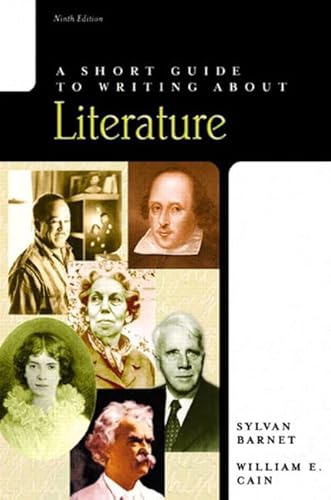Items related to A Short Guide to Writing about Literature (9th Edition)

"synopsis" may belong to another edition of this title.
Favorable response to the sixth edition has allowed me to revise the book again. Many changes have been made throughout, but the most obvious are:
The increased amount of writing by students— annotations, preliminary notes, entries in journals, drafts, and complete essays Amplified checklists with questions that writers can ask themselves in order to generate ideas for essays Amplified discussions of current critical approaches, for example, Gender (Feminist, Gay and Lesbian) Criticism, Myth Criticism, New Historicism Chapters on What Is Literature?, What Is Interpretation?, and What Is Evaluation? Bibliographic suggestions concerning criticism and interpretation Suggestions about writing with a word processor
Part One (four chapters emphasizing the close connection between reading and writing) assumes that we can't write well unless we can read well. If nothing else, we must be able to read our own prose thoughtfully. Reading, after all, is a way of getting ideas for writing. These early chapters emphasize the importance in the writing process of such activities as annotating a text, brainstorming, keeping a journal, and (especially) asking oneself questions in order to generate ideas. (Oddly, these activities are often called "pre-writing," but in fact they are part of the process of writing.) Explication and analysis are discussed and illustrated with examples.
Part Two, on thinking critically about literature, is almost entirely new to the book. It looks at some definitions of literature, considers the relationships among interpretation, meaning, and evaluation, and then offers a survey of some of the chief critical approaches.
Part Three, on writing about essays, fiction, poetry, drama, and film, introduces the reader to the elements of each genre, but looks back to Part One and provides some drafts and essays by students on representative works. In accordance with the assumption in Part One that asking questions is an invaluable way of getting ideas, each chapter on writing about a genre concludes with a checklist of questions that readers may ask themselves as they read, reread, and think about a work.
Part Four contains three chapters. The first of these, "Style and Format," is a fairly short and direct approach to the elements of clear writing. It treats such matters as denotation, connotation, subordination, paragraphing, and so forth. The latter part of the chapter, devoted to manuscript form, is concerned chiefly with mechanical matters, ranging from the form of the title of an essay to advice on how to introduce quotations. The second chapter in this section, "Writing a Research Paper," includes material on discovering a topic and thesis, on finding material (not only through printed bibliographic guides but also through materials on line and on disc), on using a word processor in writing a research paper, and on the MLA system of documentation. The third chapter briefly discusses essay examinations.
Three appendixes conclude the book: The first includes two stories ("Araby' and "The Lottery") that are the subjects of student essays, the second provides a glossary of literary terms, and the third offers a checklist for writing with a word processor.
I hope that the preceding remarks adequately describe the scope of the book, but some further words must be added. Dr. Johnson said,
There is not so poor a book in the world that would not be a prodigious effort were it wrought out entirely by a single mind, without the air of previous investigators.
I cannot name all of the previous investigators who have helped shape my ideas about literature, about writing about literature, and about teaching writing, but I must acknowledge my indebtedness to Morton Berman, William Burto, and Marcia Stubbs, who never tire of improving my pages, to Lee Edelman, who contributed part of the discussion of gay and lesbian criticism, and (at HarperCollins) to Robert Ginsberg, Judith Leet, and Lisa Moore. Others, who offered valuable help when I revised earlier editions, include Rebecca Argall, James Blake, Randall Brune, David Cavitch, Warren Chelline, Charles Christensen, William Evans, Shearle Furnish, Bruce Golden, Okey Goode, Patricia Graves, Dean Hall, James Heldman, Deena Linnett, William T Liston, Janet Madden, Gratia Murphy, J. M. Pair, Diane Quantic, Virginia Shale, Isabel Bonnyman Stanley, and Tom Zaniello.
When I thought that the manuscript for this edition was in satisfactory shape, the publisher sent it to the following reviewers, all of whom offered valuable suggestions that I have now incorporated into the text: Ann Andrews, Mississippi State University; Robert Evans, Auburn University at Montgomery; Sarah Favors, South Carolina State University; Anita Obermeier, Arizona State University; Judy Stokes, Southside Virginia Community College; Juanita Smart, Washington State University; Christopher Thaiss, George Mason University; and Susan Wing, University of Nebraska Lincoln. One other reader of the manuscript must be singled out for special mention, William Cain of Wellesley College, once my student and now my teacher. His abundant and penetrating annotations of the manuscript have amply repaid me for whatever annotations I put, years ago, on his undergraduate essays.
SYLVAN BARNET
New features of this edition include: chapters on critical approaches and evaluation of literature expanded checklists for writing and reading a new sample research paper the most current MLA guidelines
"About this title" may belong to another edition of this title.
- PublisherPearson
- Publication date2002
- ISBN 10 0321104765
- ISBN 13 9780321104762
- BindingPaperback
- Number of pages400
- Rating
Buy New
Learn more about this copy
Shipping:
US$ 5.45
Within U.S.A.
Top Search Results from the AbeBooks Marketplace
A Short Guide to Writing about Literature (9th Edition)
Book Description Paperback. Condition: New. In shrink wrap. Seller Inventory # 71-01453
A Short Guide to Writing about Literature (9th Edition)
Book Description Paperback. Condition: New. Seller Inventory # Abebooks68326

